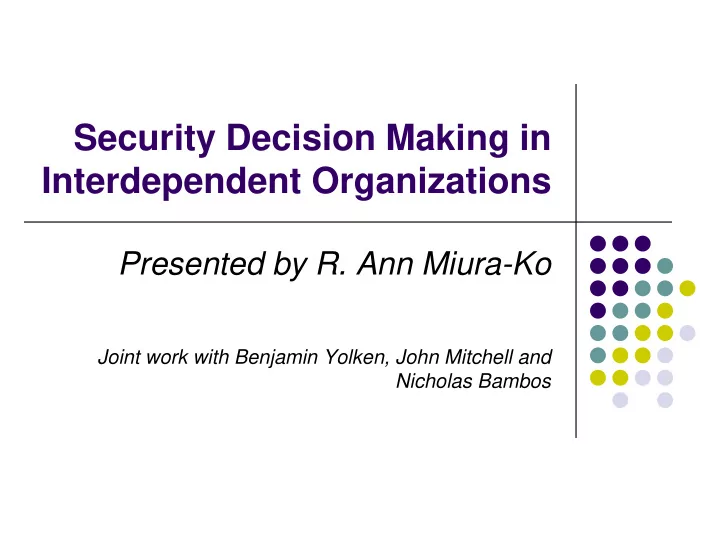

Security Decision Making in Interdependent Organizations Presented by R. Ann Miura-Ko Joint work with Benjamin Yolken, John Mitchell and Nicholas Bambos
Risk Management � Security: not a technology issue alone � Budgets and resources are limited � Human error can lead to risk � Should I invest in more user authentication? � Which kind is most effective? � Do I worry more about a high probability, low loss event or a low probability, high loss event?
Risk Management � Why is risk management of security hard? � Measurement is difficult � User incentives generally not aligned � Security as an optimization problem � Dynamic resource allocation under constraints � Game played against an adversary
Model Fundamentals � Companies make investments in security � Your security depends on: � Own investments � Neighbors’ investments � Neighbors: � Relationship ties their security to yours � Relationship: � Beneficial � Harmful
Customer Education Effort � Customers receive email communications from multiple departments at a bank � Each product group Checking Auto Loans Mortgage constructs own email Account √ √ policy Web links √ � Inconsistent messaging √ Attachments ⇒ shared risk
Anti-Spam � Investment in email path verification � Sender ID � Sender Policy Framework � Two types of companies: � Email service provider � Business / organization � Email path verification can benefit or damage anti-spam efforts of neighbors � Will everyone implement?
Web Authentication � Same / similar username and password for multiple sites � Security not equally important to all sites Shared risk for all
Motivation � Many situations where this type of model makes sense � Peer-to-peer networks and security � Social networks and privacy � Health information sharing between hospitals � Interactions can be beneficial as well as detrimental � How much free riding occurs? � Who invests and how much?
Network Model � Network = Directed Graph Nodes = Decision making � agents Links = influence / interaction � -.1 -.1 .2 .1 Weights = degree of influence � -.1 -.1 .1 .2 .2 -.1 -.1 .1 -.1 -.1 .2 .1 -.1 -.1 .1 .2
Incentive Model � Each agent, i , selects investment, x i -.1 -.1 .2 .1 � Security of i determined by -.1 -.1 .1 .2 total effective investment: .2 -.1 -.1 .1 -.1 -.1 .2 .1 � Benefit received by agent i: -.1 -.1 .1 .2 � Cost of investment: � Net benefit:
How will agents react? � Single stage game � All agents maximize their utility function: � b i is where the marginal cost = marginal benefit for agent i slope = c i V i � If neighbor’s contribution > b i , x i =0 � If neighbor’s contribution < b i , x i = difference b i x i
How will agents react? � All agents maximize their utility function: � b i is where the marginal cost = marginal benefit for agent i � Each node seeks a level of b i effective investment
What is an equilibrium? � Nash Equilibrium � Stable point (vector of investments) at which no agent has incentive to change their current strategy � This happens when: � Leverage Linear Complementarity literature
Analysis of the Model � Diagonal Dominance: � Existence and uniqueness of Nash Equilibrium � Convergence to the Nash Equilibrium in a distributed, asynchronous manner
Free Riding � Since others are contributing to an agent’s investment, some may choose not to invest at all � Measure of contribution relative to what they need, free riding index:
Web Authentication � Utility function: -.1 -.1 .2 .1 -.1 -.1 .2 .1 -.1 -.1 .1 .2 -.1 -.1 .1 .2 .2 -.1 .2 -.1 .1 -.1 .1 -.1 -.1 -.1 .2 .1 -.1 -.1 .2 .1 -.1 -.1 .1 .2 -.1 -.1 .1 .2
Conclusion � Application of risk management modeling to real scenarios in security � Future direction: � Optimization to improve equilibria � Possible relaxations of diagonal dominance restriction
Recommend
More recommend